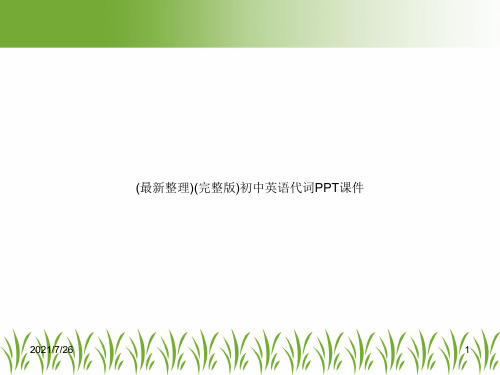【通用版】中考英语总复习:代词ppt 专项超详细讲解
合集下载
中考英语专题复习课件 代词(共20张PPT)

专题----- 代词
知识框架图
主格 人称代词 宾格 形容词性物主代词 物主代词 名词性物主代词 第一人称反身代词 反身代词 第二人称反身代词 第三人称反身代词 单数指示代词 指示代词 复数指示代词 普通不定代词 不定代词 复合不定代词 疑问代词 who, whom, whose, what,which 关系代词 who, whose, whom,that,which 相互代词 each other, one another 代词it的特殊用法
重难点精讲 2. some与any的用法比较 3. few, a few与little, a little的用法比较 4. other, the other, others, the others, another 【现学现用】 13..Do you know Yao Ming and Yi Jianlian? ―Yes, they are ____ basketball players from NBA. A. all B. both C. neither B
4. 反身代词常见的固定的搭配有: help oneself(to) 自用(食物等); enjoy oneself 玩得愉快 ; dress oneself 自己穿衣服; hurt oneself 伤害自己 teach oneself 自学; lose oneself 失去自我 by oneself 单独地,独自地; for oneself 为自己
重难点精讲 物主代词口诀 物主代词分形、名,形式用法各不同; 形容词性先出场:我的my你的your; 男的his女的her,它的its不加撇; 我们的our他们的their,别忘记! 物主代词形变名,多数词尾加“s”; my变mine须分明,his和its是本身; 形跟名词,名不跟,用法牢记不会错!
知识框架图
主格 人称代词 宾格 形容词性物主代词 物主代词 名词性物主代词 第一人称反身代词 反身代词 第二人称反身代词 第三人称反身代词 单数指示代词 指示代词 复数指示代词 普通不定代词 不定代词 复合不定代词 疑问代词 who, whom, whose, what,which 关系代词 who, whose, whom,that,which 相互代词 each other, one another 代词it的特殊用法
重难点精讲 2. some与any的用法比较 3. few, a few与little, a little的用法比较 4. other, the other, others, the others, another 【现学现用】 13..Do you know Yao Ming and Yi Jianlian? ―Yes, they are ____ basketball players from NBA. A. all B. both C. neither B
4. 反身代词常见的固定的搭配有: help oneself(to) 自用(食物等); enjoy oneself 玩得愉快 ; dress oneself 自己穿衣服; hurt oneself 伤害自己 teach oneself 自学; lose oneself 失去自我 by oneself 单独地,独自地; for oneself 为自己
重难点精讲 物主代词口诀 物主代词分形、名,形式用法各不同; 形容词性先出场:我的my你的your; 男的his女的her,它的its不加撇; 我们的our他们的their,别忘记! 物主代词形变名,多数词尾加“s”; my变mine须分明,his和its是本身; 形跟名词,名不跟,用法牢记不会错!
中考英语代词复习(共43张PPT)

Rewrite the sentences. Eg: This baby is Ne Zha. Ne Zha is a boy.
He
人称代词
主格+V+宾格
1. Ne Zha's mother has long hair. Ne Zha's mother loves Ne Zha very much.
核心语法代词代词概述人称代词指示代词物主代词反身代词疑问代词丌定代词人称代词主格和宾格形容词性物主代词和名词性物主代词反身代词丌定代词名词性物主代词用法丌定代词用法及辨析知识点重点难点代词分类知识点人称代词物主代词反身代词指示代词疑问代词不定代词rewritethesentences
核心语法-代词
知识点
Ne Zha's mother's coat is purple. Her coat =Hers
Ao Bing's coat is white. His =His coat
优秀ppt公开课ppt免费课件下载免费 课件中 考英语 代词复 习(共4 3张PPT )
知识点
物主代词
物主代词的分类
优秀ppt公开课ppt免费课件下载免费 课件中 考英语 代词复 习(共4 3张PPT )
人称代词的分类
单数
主格
宾格
I
me
复数 主格 宾格
we
us
you
you
you you
he
him
she
her
they them
it
it
人称代词
人称代词的练习 1
完成句子
1.我现在正在学英语。____I_____ am studying English now. 2. 我们热爱我们的国家。___W___e___ love our country. 3.你能帮助我们吗?Can you help ___u__s____? 4.我们正在等他们。__W__e___ are waiting for__t_h__e_m___. 5.是谁呀?是我。Who is there? It’s ___m___e____.
He
人称代词
主格+V+宾格
1. Ne Zha's mother has long hair. Ne Zha's mother loves Ne Zha very much.
核心语法代词代词概述人称代词指示代词物主代词反身代词疑问代词丌定代词人称代词主格和宾格形容词性物主代词和名词性物主代词反身代词丌定代词名词性物主代词用法丌定代词用法及辨析知识点重点难点代词分类知识点人称代词物主代词反身代词指示代词疑问代词不定代词rewritethesentences
核心语法-代词
知识点
Ne Zha's mother's coat is purple. Her coat =Hers
Ao Bing's coat is white. His =His coat
优秀ppt公开课ppt免费课件下载免费 课件中 考英语 代词复 习(共4 3张PPT )
知识点
物主代词
物主代词的分类
优秀ppt公开课ppt免费课件下载免费 课件中 考英语 代词复 习(共4 3张PPT )
人称代词的分类
单数
主格
宾格
I
me
复数 主格 宾格
we
us
you
you
you you
he
him
she
her
they them
it
it
人称代词
人称代词的练习 1
完成句子
1.我现在正在学英语。____I_____ am studying English now. 2. 我们热爱我们的国家。___W___e___ love our country. 3.你能帮助我们吗?Can you help ___u__s____? 4.我们正在等他们。__W__e___ are waiting for__t_h__e_m___. 5.是谁呀?是我。Who is there? It’s ___m___e____.
中考英语语法专题讲解——代词 (共26张PPT)

both, all与none
both表示“两者都”,all指三者或者三者以上都;none 指三者或者三者以上都不,常用来回答how many/much 引出的问题。 Both of my parents are farmers. All of us should go there. None of the students in our class can work out the maths problem. --How much rice do you need? --None.
the other, another, other, others, the others
复合不定代词
复 合 不 定 代 词 为 : somebody, someone, something, anybody, anyone, anything, nobody, nothing, everybody, everyone, everything。
特别提醒
it特指上文提到的同一个事物,同类且同物;one泛指上文提及 到的同类事物中的一个,同类而不同物;that常用于比较结构中, 代替前面提到过的可数名词单数或者不可数名词,以避免重复, 代替复数名词时用those。 The book is mine. It is very interesting. --Who has a pen? --I have one. The weather in Beijing is colder than that in Guangzhou in winter.
中考英语语法专题讲解——代词
代词的种类
人称代词 指示代词
物主代词 不定代词
反身代词 疑问代词
人称代词
1、人称代词的主格在句中充当主语。 I love my country. She is a good student. 2、人称代词的宾格在句中充当宾语或者表 语。
代词知识点详解(14张PPT)初中英语专题复习课件

enjoy oneself 玩得开心 help oneself to 随便(吃、喝) lose oneself in... 沉浸在……之中
反身代词
➢ 例 Help
to some fish, Jim.
A. himself
B. herself
C. yourself
➢ 解析 句意:吉姆,随便吃些鱼吧。考查短语help oneself to sth."随便吃/
指代离自己较近的人或物 this, these
指代离自己较远的人或 物 比较结构中代替前面提 到的名词,以免重复
that, those
疑问 代词
指示 代词
不定 代词
代词
人称 代词
物主 代词
反身 代词
语法图解
someone/somebody/something, anyone/anybody/anything, nobody/nothing everyone/everybody/everything等
many/much, few/a few, little/a little, other/the other/another/others, some/any, either/neither/both/all等
复合 不定 代词
普通 不定 代词
疑问 代词
指示 代词
不定 代词
代词
人称 代词
物主 代词
反身 代词
人称代词与物主代词
区分 人称代词
用法
成分
指代人或物 作主语(主格),作宾语(宾格)
物主代词
表示所有关系
形容词性物主代词作定语 名词性物主代词=形容词性物主代词+名词,具有名 词特性,可作主语、宾语、宾补
中考英语代词专项复习课件PPT教学

feel
第25页/共30页
沙场练兵
We our 1._____ love ______ countr y and we’ll make it more beautiful.(we)
2. ______ studies in a middle school near ____ home. ( he)
3. ______ ______ do it.( I )
h两is种b物ike主. 代词的不同用法:
They love their work in the
fac小to结r:y.形容词性物主代词+名词
第9页/共30页
两种物主代词的不同用法
2)名词性物主代词应单独使用,后面不跟名词:
May I use your ruler? I have lost mine. May I use your ruler? I have lost my ruler.
第19页/共30页
五 .it, one, that 作代词的区别
①it指上文提到过的事物。
② one泛指上下文提及的同类事物中的一个。
③that常用于比较结构中,代替前面提到的名词,
避免重复.
例如:
(1) I have many books. Whicohn_e___ do
you like?
(2) The book is mine.It____ is very
boys. A.yourself B. yourselves
第15页/共30页
4.Where’s your mother? I can’t find ____ anywhere.
A . she B. her C. he D. him
5.Mike’s words are different from____. We really can’t agree with_____.
第25页/共30页
沙场练兵
We our 1._____ love ______ countr y and we’ll make it more beautiful.(we)
2. ______ studies in a middle school near ____ home. ( he)
3. ______ ______ do it.( I )
h两is种b物ike主. 代词的不同用法:
They love their work in the
fac小to结r:y.形容词性物主代词+名词
第9页/共30页
两种物主代词的不同用法
2)名词性物主代词应单独使用,后面不跟名词:
May I use your ruler? I have lost mine. May I use your ruler? I have lost my ruler.
第19页/共30页
五 .it, one, that 作代词的区别
①it指上文提到过的事物。
② one泛指上下文提及的同类事物中的一个。
③that常用于比较结构中,代替前面提到的名词,
避免重复.
例如:
(1) I have many books. Whicohn_e___ do
you like?
(2) The book is mine.It____ is very
boys. A.yourself B. yourselves
第15页/共30页
4.Where’s your mother? I can’t find ____ anywhere.
A . she B. her C. he D. him
5.Mike’s words are different from____. We really can’t agree with_____.
代词考点详解(15张PPT)初中英语专题复习课件

“任何数量;任何一些”,指代复数 里 有 吗 ? Please buy some milk. There
名词或不可数名词
isn’t any left in the fridge. 请买些牛奶。
冰箱里一点也没有了。
I have three dictionaries. You may use
② 用于肯定句中,表示“任一”
(5)复合不定代词的用法
由 some , any , every , no 与 one , body , thing 一 起 构 成 的 代 词 叫 复 合 不 定 代 词 , 如 something,everybody,anyone,nothing等。由one和body构成的复合不定代词可相互换用。
结构
另一个是老师。
其他全部,其余的。表示在一个范 围内的其他全部
In our class only Tommy is English, and the others are Chinese. 我们班除了汤米是英国人外,其他都是中国人。
另一个(指多个中的任何一个),可 You can see another ship in the sea, can’ t
第二人称
单数 复数 单数 复数
汉语 我的 我们的 你的 你们的
形容词性 my our your your
名词性 mine ours yours yours
他 he him
他的 his his
第三人称
单数
她
它
she
it
her
it
第三人称 单数 她的 它的 her its hers its
复数 他们 they them
三、反身代词
反身 代词
代词高频考点(19张PPT)初中英语专题复习课件

This is my book and that is yours. 这是我的书,那本是你的。
Do remember this:Never put off what you can do today till tomorrow. 一定要记住这一点:今日事今日毕。
This is my friend,Bob. 这是我的朋友鲍勃。
The weather in Guangzhou is much warmer than that in Beijing in winter. 冬天广州的天气比北京的暖和得多。
The pears on this tree are bigger than those on that one. 这棵树上的梨比那棵树上的大。
代词 初中英语专题复习课件
Contents
目录
01. 人称代词
04. 不定代词
02. 物主代词
05. 指示代词
03. 反身代词
06. 疑问代词
一二
一、人称代词 人称代词即代指对人或物的称呼的词(你、我、他等),分为主格和宾格两种形式。
分类
主格(在句 中做主语)
宾格(在句 中做宾语)
单数
I you he she it
名词性物主代词
(当作名词使用)
单数
复数
—Whose bike is this? ——这是谁的自行车? —It’s mine. ——是我的。(mine=my
bike)
一二三
三、反身代词 反身代词就是代指某人自己,单数以-self结尾,复数以-selves结尾。
第一人称 单 数 myself 复 数 ourselves
第一人称 第二人称
第三人称
代词考点详解(33张PPT)初中英语专题复习课件

A. nobody B. none C. nothing D. no one
考点2:不定代词
常见易混不定代词辨析
4. other, the other, others, the others与another
词(组)
含义及用法
固定搭配
other 形容词,别的,修饰名词)
/
the other 另一个(特指,两者中的)
h_e__r_s_e_l_f it_s_e_l_f__ th__e_m__s_e_l_v_e_s_
考点1:人称代词、物主代词与反身代词 人称代词的用法
1. 人称代词的主格在句中作主语,用在动词之前;宾格 在句中作宾语,动词或介词之后,也可作表语,用在系 动词之后。 1.We listen to music at lunchtime. 2. His mother kisses him goodbye every morning when she leaves for work. 3. Remember to give it back to him.
—I don't know. Because I still have too ___A___ to do!
A. much B. many C. every D. any
4.Though she talks _C___,she has made ____friends here
A. a little,a few
are about the latest information of it.
A. either B. neither C. both
D. all
4. I want to buy a fine watch for my father on Fatherˈs Day, but
最新代词 中考英语语法专项复习(全国通用)(共66张PPT)教育课件

【专题课件】中考英语 代词的知识点、考点与
经典高频考题专题精讲
(超全精编版)
课程介绍
本节课程在本学科中的地位
通过学习本章的六种代词类型的知识点讲解及经典例题、真题再 现的形式,再通过模拟考题的巩固,意在让学生掌握人称代词、 物主代词、指示代词、反身代词、关系代词、疑问代词的做题方 法,并做到灵活运用,以便提高综合运用能力,增强学习的信心。
经典例题精讲
经典例题3
The boy called his teacher for help because he couldn’ t
solve the problem by ____B________.
A. herself
B. himself
C. yourself
D. themselves
【解析】主语为he,指the boy,反身代词用himself。
—Hello, this is Martin.
A. he C. that
B. one D. this
【解析】由对话内容可知,是打电话用语。询问对方是 谁时,要用that。
5 不定代词
定义
不明确指代某个人、某个事物、某 些人、某些事物的代词叫不定代词。 不定代词可以代替名称和形容词, 表示不同的数量概念。不定代词没 有主格和宾格之分,在句中可作主 语、表语、宾语和定语等。
1 人称代词
分类:人称代词主格和人称代词宾格
人称
第一人称 第二人称 第三人称
主格 I
you he
单数 宾格 me you him
复数 主格 we you they
宾格 us you them
1 人称代词
(1)通常主格作主语(在 句首,动词前)。 ► He likes swimming. 他 喜欢游泳。
经典高频考题专题精讲
(超全精编版)
课程介绍
本节课程在本学科中的地位
通过学习本章的六种代词类型的知识点讲解及经典例题、真题再 现的形式,再通过模拟考题的巩固,意在让学生掌握人称代词、 物主代词、指示代词、反身代词、关系代词、疑问代词的做题方 法,并做到灵活运用,以便提高综合运用能力,增强学习的信心。
经典例题精讲
经典例题3
The boy called his teacher for help because he couldn’ t
solve the problem by ____B________.
A. herself
B. himself
C. yourself
D. themselves
【解析】主语为he,指the boy,反身代词用himself。
—Hello, this is Martin.
A. he C. that
B. one D. this
【解析】由对话内容可知,是打电话用语。询问对方是 谁时,要用that。
5 不定代词
定义
不明确指代某个人、某个事物、某 些人、某些事物的代词叫不定代词。 不定代词可以代替名称和形容词, 表示不同的数量概念。不定代词没 有主格和宾格之分,在句中可作主 语、表语、宾语和定语等。
1 人称代词
分类:人称代词主格和人称代词宾格
人称
第一人称 第二人称 第三人称
主格 I
you he
单数 宾格 me you him
复数 主格 we you they
宾格 us you them
1 人称代词
(1)通常主格作主语(在 句首,动词前)。 ► He likes swimming. 他 喜欢游泳。
中考英语语法复习 代词讲解(共26张PPT)

Nancy is a P.E teacher. I’ve known her for years.
2)两个以上的人称代词并列时,其次序排列原则: 二三一 人 称. “我”总是放在最后, 在并列主语中,排列顺序为: you, she/he and I, 并列宾格: you, her/ him and me,
It is fifteen years since he came to Shanghai.
5)在一些惯用结构中作形式主语或形式宾语 It is important for us to learn English well. It is kind/nice of you to help me 。 I find/think it useful to read English every day. It is said that an traffic accident happened to him last night It seemed that his interview was a success.
优秀ppt公开课ppt免费课件下载免费 课件20 20 中考英语语法复习 代词讲解(共26张PPT)
指示代词的特殊指代功能: 1.介绍别人时要用 this is;
This is Miss Li. This is Tom 2.this 常指下文中要讲到的事物,有启下的作用;
that 则指上文中提到过的人/事物有承上的作用。
I want to tell you this: The party will be put off. He hurt his leg yesterday. That's why he didn't come.
优秀ppt公开课ppt免费课件下载免费 课件20 20 中考英语语法复习 代词讲解(共26张PPT)
2)两个以上的人称代词并列时,其次序排列原则: 二三一 人 称. “我”总是放在最后, 在并列主语中,排列顺序为: you, she/he and I, 并列宾格: you, her/ him and me,
It is fifteen years since he came to Shanghai.
5)在一些惯用结构中作形式主语或形式宾语 It is important for us to learn English well. It is kind/nice of you to help me 。 I find/think it useful to read English every day. It is said that an traffic accident happened to him last night It seemed that his interview was a success.
优秀ppt公开课ppt免费课件下载免费 课件20 20 中考英语语法复习 代词讲解(共26张PPT)
指示代词的特殊指代功能: 1.介绍别人时要用 this is;
This is Miss Li. This is Tom 2.this 常指下文中要讲到的事物,有启下的作用;
that 则指上文中提到过的人/事物有承上的作用。
I want to tell you this: The party will be put off. He hurt his leg yesterday. That's why he didn't come.
优秀ppt公开课ppt免费课件下载免费 课件20 20 中考英语语法复习 代词讲解(共26张PPT)
中考英语总复习课件:代词复习课件 (共31张PPT)

She has two sons.One is in Beijing,the other is in Shanghai. 她有两个儿子。一个在北京,另 一个在上海。 There are lots of people in the park.Some are dancing, and others are boating.公园里有许多人,有 些人在跳舞,有些人在划船。
一、人称代词及物主代词的构成及用法 人称代词不仅指人,也可指物,有人称、数和格的变化。物主代词是表示 所有关系的代词,是人称代词的属格形式,表示“所有”关系。
类别 人称代词主格(单数) 人称代词主格(复数) 人称代词宾格(单数) 人称代词宾格(复数) 形容词性物主代词(单数) 形容词性物主代词(复数) 名词性物主代词(单数) 名词性物主代词(复数)
any
既可指代或修饰可数名词 ,也可指代或修饰不可
There
isn't
any
(一些; 数名词。多用于疑问句、否定句和条件句中 ,表 任一)
milk in the fridge.
冰箱里没有牛奶 示“一些”,也可用于肯定句中,表示“任一”。 了。
五、常用不定代词辨析 1.some 与 any 词汇 用法 既可指代或修饰可数名词复数 ,也可修饰或指代 例句
ourselves yourselves
2. 指示代词是用来指代或标记人或事物的代词,表示“这个/ 些”“那个/ 些”。常用的指示代词有 this,that,these,those。 指示代词 近指 远指 单数 复数 this that these those √ √ √ √ √ √ √ √
3.指代时间或季节。如: —What's the time now? 现在几点了? —It's half past six.六点半。 4.指代天气。如: —What was the weather like yesterday? 昨天天气怎么样? —It was windy.有风。
(最新整理)(完整版)初中英语代词PPT课件

2021/7/26
4
一
二
三
四
五
六
七
一、人称代词
人称代词是用来指人、动物或其他事物的代词,它的主要用途是 在句子中避免名词的重复,人称代词有单复数以及主格与宾格的变 化。
1.人称代词的分类
人称
单数 主格
宾格
复数 主格
宾格
第一人称 I(我) me(我) we(我们) us(我们)
第二人称 you(你) you(你) you(你们) you(你们)
作表语 常与系动词 be,look,seem,feel 连用,描述一种感觉、情绪或状态
作同位 语
用来加强语气,作主语的同位语时,有时为了使句子平衡,常把它放 在句末
I teach myself English.我自学英语。 I don’t feel myself today.我今天感觉不舒服。 You can do it by yourself.你能自己做。
关闭
B
2021/7/26
解析
答案
23
一
二
三
四
五
六
七
4.The iPad isn’t
.It belongs to
.
A.he;me B.hers;mine
C.his;me D.her;mine
关闭
第一空需用名词性物主代词作表语,故排除 A、D 两项;再由 belong to 中的 to 是介词后跟人称代词的宾格,排除 B 项。故选 C 项。
句意:——你可以给我看看你的字典吗?——好的。给你。show
sth.to sb.“把某物展示给某人看”。在此短语中 sb.作“to”的宾语,故用
人称代词的宾格。
代词知识点详解课件 (30张PPT)初中英语专题复习

复习练习 复习知识点导图,重复练习,直到非常熟悉为止
初中英语高效学习
要点总结
本节内容
代词 代词的分类 指示代词 人称代词 物主代词 反身代词 不 定代词 疑问代词 相互代词 关系代词
初中英语高效学习
注意事项提醒
TIPS 1
要特别注意人称代词 主格和宾格的使用区
别。
TIPS 2
要注意形容词性物主 代词和名词性物主代
PART 1
构建知识点导图 助你了解所有知
识点
Create a mindmap
初中英语高效学习
代词知识点导图仪表盘:
代词知识点导图代词的种类细节图:
初中英语高效学习
代词知识点导图指示代词细节图:
代词知识点导图人称代词细节图1:
代词知识点导图人称代词细节图2:
代词知识点导图物主代词细节图1:
代词知识点导图物主代词细节图2:
代词知识点导图反身代词细节图:
代词知识点导图不定代词细节图:
代词知识点导图疑问代词细节图:
代词知识点导图互相代词细节图:
代词知识点导图关系代词细节图1:
代词知识点导图关系代词细节图2:
代词知识点导图总导图:
PART 2
利用知识点导图来解题 此部分务必观看视频讲
初中英语高效学习
例题2
She hit him on A. the B. his C. her D. he's
head.
初中英语高效学习
答案
A,本题考查人称代词及冠词用法。表示“打了某人某地方(部位)”, 因宾语巳表明 了“身份”,故在某部位前只用”the“,不再重复“某人”了,此题不能错选B。
初中英语高效学习
代词
- 1、下载文档前请自行甄别文档内容的完整性,平台不提供额外的编辑、内容补充、找答案等附加服务。
- 2、"仅部分预览"的文档,不可在线预览部分如存在完整性等问题,可反馈申请退款(可完整预览的文档不适用该条件!)。
- 3、如文档侵犯您的权益,请联系客服反馈,我们会尽快为您处理(人工客服工作时间:9:00-18:30)。
注
(1)some和any都可以表示“一
意
些”,既可以修饰可数名词,也可 以修饰不可数名词。
(2)some一般用于肯定句中,any多用于疑问 句和条件句中。
(3)在疑问句中,若要表示说话人希望得 到肯定的回答或者表示请求、建议时用some。 any也用于肯定句中,表示“任何”。
2. many 和 much 两者都表示“许多,大量”。
You, she and I should help each other.
注意事项
(2) 如果是承担责任,说话者应把第一人称放在第 一位。
eg: I and Tom broke the window.
(3)复数形式“一、二、三”(we, you and they)
eg: We, you and they should help each other.
2 表示不确定的数量的不定代词
many 许多 few 很少 most 大部分
much 许多 little 很少 all 全部
3 表示不确定的选择的不定代词
either 两者中的任意一个 neither 两者中没有一个 none 三者或三者以上
不定代词
不明确指代某个人、 某些人或某些事物 的代词。
第一人 第二人
称
称
your his her its our your
第三人 称
their
yours his hers its ours yours theirs
用法
形容词性物主代词+名词
1. 形容词性物主代词起形容词的作用,在句中只 能作定语,即形容词性物主代词后面一定要接 一个名词。
eg: My books are over there.
Exercise
1. Who taught ____________ maths last year ?
A. they
B. their
C. them
D. theirs
taught teach教的过去式
teach sb. sth 系动词后是表语
2. Reading more helps _______ learn better.
eg: They are all good students. She is going to another city.
her
(2)人称代词的宾格形式在句中作宾语和表 语。
eg: Do you understand her ? 宾语 her name is Rachel.表语 We are waiting for you. 宾语
反身代词
人 称 数
单数
第一人称
myself
第二人称
第三人称
yourself himself herself itself
复数 ourselves yourselves
themselves
习惯用语
Exercise
5. We can’t leave our grandparents by _____.
不明确指代某个人或某些人、某个事物或某些事物 的代词。
不定代词
1 表示不确定的人或事物的不定代词
one 某人或事物 no 没有 other 别的
some 某个某些
any 任何一个
each/every 每个 none 没有
another另一个
something 某事
somebody/someone 某人 anybody /anyone 任何一个人 everybody/everyone 每个人 nobody/no one 没有人
e.g. There are so many books that I don’t know which to choose.
I’ ve got too much work to do.
注
(1)many 修饰可数名词;
意 (2)much修饰不可数名词;
(3)两者都可以与表示程度的副词 so, too, how连用。
4. this,that在电话用语中可以指自己和对方。
eg: A: Is that Mr. Smith speaking ? B: Who is that ? A: This is Mary, Mr. Smith.
疑问代词
用来表达疑问或构成 疑问句的代词。
格
指代 指人
指物
指人或物
主格 who what which
A. We
B. us
C. our
D. ours
物主代词 My book is on the desk, yours is on the table. = your book
名词性物主代词= 形容词性物主代词+名词
数
单数
复数
人称 格
形容词性物主代 词
名词性物主代词
第一人 称
my
mine
第二人 称
第三人称
单数人称代词 231 承担责任 123 复数形式 123
Exercise
1.________(我) am a teacher. 2.My father is talking with _______(我). 3._______(他) often plays basketball after school. 4._______(我们) buy a pair of shoes for _______(他). We 主格 our 形容词性物主代词 us 宾格 him
Those cars are made in China.
2. this/ these一般指时间或空间上较近的人或物而 that/those常指时间上或空间上离说话人较远的 人或物。
eg: This present is for you and that one is for your mom.
We are very happy these days.
I haven’t read either of these (books). Either you or he is right.
(2) neither 表示“两者都不”。 e.g. neither of us has been to Beijing.
She is neither clever nor hardworking.
常见不定代词的用法和辨析:
1. Some, any 2. many, much 3. both, all, either, neither 4. none, no one 5. few, a few, little, a little 6. each, every 7. it, one, that 8. other, another
1. Some 和 any Some 和any 均表示“一些”。 e.g. :There are some trees behind the house.
Do you have any questions ? Would you like some tea? You may go there any time.
I have lost my dictionary. Please lend me yours. 宾语 your dictionary
Exercise
1.My book is blue. __Yours_______(you) is red. 2.Our chair is better than __ chair( they). 3.I will give the presents to________(they). 4.These books are________(I), and those are____(you).
3. both, all
(1) both表示“两者都”。
e.g. Both plans are good. Both she and I are students.
(2) all “表示三者或三者以上都”。
e.g. They all agree to stay here. All of us don’ t like tea.
I was looking for my glasses everywhere.
(2) 名词性物主代词起名词作用,因 此其后不能接名词。在句中可作主 语,表语,宾语。
eg: It isn’t your ruler. It’s mine. 表语
Yours is in your desk. 主语 your ruler
代词的种类
人称代词
物主代词
反身代词
指示代词 不定代词
疑问代词
人称代词
主语 宾语 表语 系动词后面的部分就是表语
数 人称 格
第一人称 第二人称
第三人称
单数
主格
宾格
I
me
you
you
he
him
数
主格
宾格
we
us
you
you
they
them
1.句法功用
(1)人称代词的主格形式在句中作主语等成 分。
4. Which 的用法
Which表示在一定范围内选择,意为 “哪一个”,回答通常为一个。 Eg :This is mine. Which is yours ?
which of you is the oldest? which would you like, tea or coffee? which book is more interesting ?
Open the door. It’s me. It is me.
2. 注意事项
如果同时出现多个人称代词,注意排序。
(1) 为了表示礼貌和谦虚,排列次序总是习惯将 第二人称、第三人称放在前面,将第一人称放在 后面。单数 “二三一 you he /she/it I”
